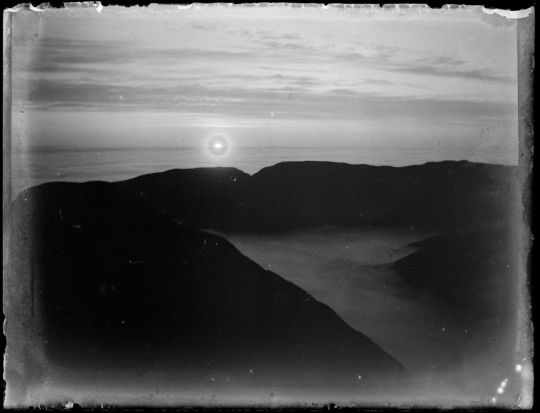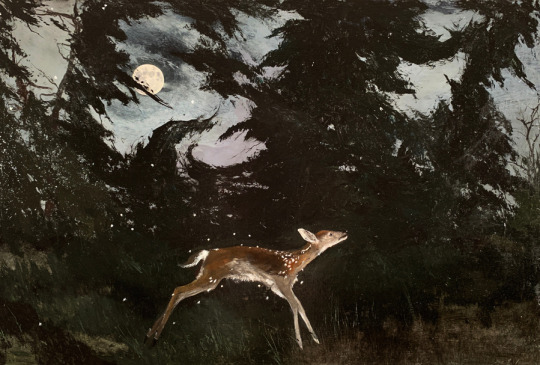Text
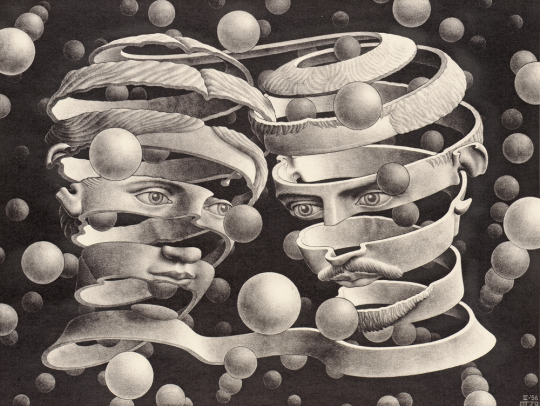
Maurits Cornelis Escher (Dutch, 1898–1972), "Bond of Union", 1956
667 notes
·
View notes
Text
"Perfect nonsense goes on in the world. Sometimes there is no plausibility at all."
- Nikolai Vasilievich Gogol
2 notes
·
View notes
Text
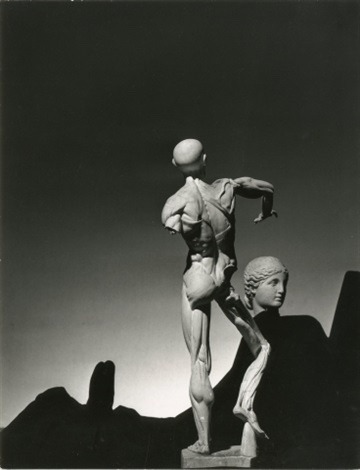
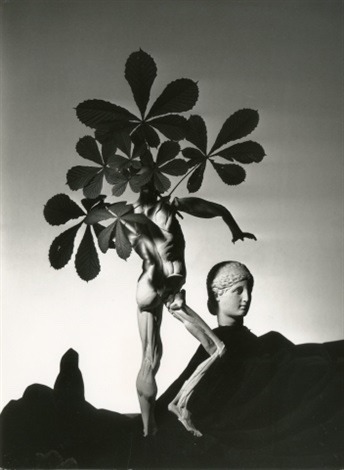
Genia Rubin, Pendant, après, composition surréaliste, 1939
Genia Rubin, Avant, composition surréaliste, 1939
14 notes
·
View notes
Text
reviews | literature | novels | play of form
𝐓𝐞𝐧𝐝𝐞𝐫 𝐢𝐬 𝐭𝐡𝐞 𝐭𝐡𝐨𝐮𝐠𝐡𝐭 𝐨𝐟 𝐭𝐫𝐚𝐧𝐬𝐟𝐨𝐫𝐦𝐚𝐭𝐢𝐨𝐧
Lisa Samuels’ complex coming-of-age story dances the surrealist dialogue
.·:*¨༺ __________________

Les Chants de Maldoror with an illustration by René Magritte, 1948.
Sink your teeth into the soil and hold onto it. Figuratively speaking, this is exactly what Lisa Samuels’ unnamed main character does at the beginning of Tender Girl (2015). Like evolution, the novel’s story begins in the water and ends on land. And an evolution it certainly is – the evolution of a girl who is new to the sweet achings of the human world. Samuel’s thirteenth work is a coming-of-age story of the unusual kind: with a strange protagonist and stranger prose.
Tender Girl opens by washing up its leading figure on the shore of humankind. Girl, as she is simply called throughout the story, is a peculiar hybrid being – half human and half shark. For the first time, she steps out of the ocean and carefully makes her way into a strange new world. Drinking up the unfamiliar encounters with a wondrous soul, she learns to navigate the complexity of human existence and what it means to be a woman. As she grows up, Girl experiences love, and violence, and art, and grief, and motherhood, and loneliness – and the language of herself. Lisa Samuels approaches this exploration in a complex linguistic way. One which often eludes the rules of syntax and grammar, instead radically striving for a stormy stream of consciousness.
"That untranslatability being the half-slipped land-slide kind of 'person-hood' she's noticing in the other body eyes and talk she hears conveyed. How do they keep from fundamental loneliness?"
- Tender Girl (2015)
Although not expressively labeled as surrealist, Tender Girl certainly is evocative of the style: the work embodies the idea of a metamorphosis of being. Through its themes and its form – both of subversive nature – Samuels’ novel conducts a conversation with the past movement.
(Tender) Girl is the child of a well-known father: the work takes direct inspiration from Les Chants de Maldoror, a poetic novel written by the French author Comte de Lautréamont in 1869. Lautréamont’s piece approaches transgressive topics such as violence, evil, and absurdity through the actions of its misanthropic main character Maldoror. In one scene, a bizarre sequence of events climaxes when he violently mates with a shark. In the diegesis Samuel has created, her protagonist is the offspring of this brutish encounter, and Tender Girl an informal follow-up of the 19th-century tale.
Decades after its initial publication, Les Chants de Maldoror was embraced by the Surrealist movement, being hailed as a ‘proto-surrealist’ masterpiece for its subversive themes and absurd contents. Lisa Samuels expands on Lautréamont, plucking Girl from the tree of his fictional sphere and giving her a unique voice. Through this continuation, the author places her protagonist in direct relation to the avant-garde movement: both Les Chants de Maldoror and Tender Girl are explorations of transformations. Just as the source material which Girl is given birth from utilizes surrealist concepts, so, too, does Samuel’s work absorb and reform them.
"She licks her tears away from her lower face, her pink tongue on the blue of her skin. The strawberries and the tentacles are softer than anemones."
- Tender Girl (2015)
The novel’s linguistic style is an ungraspable creature, an ever-changing chimera of words. The author thrusts away any coherency of sentence structure or syntax or grammar, freeing language from the shackles of coherence. Seldomly can the reader guess how a sentence will end. Samuels’ prose is an immediate representation of the protagonist’s fluctuating feelings. While Girl shifts and changes and grows in the world she explores, the narration responds. Through this, Tender Girl holds the theme of metamorphosis in its very form.
Lisa Samuel’s novel has glistering sharp teeth, and they have sunken deeply into the soil of Surrealism. Tender Girl is an anamorphic absurdity in contemporary shape, its complex form speaking the same language as the concepts that have conceived it.
__________________ ༻¨*:·.
#surrealism#surrealist art#surrealist literature#literature#novels#prose#formalism#review#book review#tender girl#lisa samuels#les chants de maldoror#comte de lautréamont#thechimerasreviews
3 notes
·
View notes
Text
.·:*¨༺ ༻¨*:·.
𝐖𝐞𝐥𝐜𝐨𝐦𝐞 𝐭𝐨 '𝐓𝐡𝐞 𝐂𝐡𝐢𝐦𝐞𝐫𝐚'𝐬 𝐃𝐢𝐚𝐫𝐲'

.·:*¨༺ __________________
As you can tell, the chimera sometimes speaks in tongues.
To understand more about what this project aims at, click on 'about' in the side bar.
To explore some sense-making words, check out the chimera's reviews about surrealism in contemporary media - they can be found by scrolling down, if you dare. For more immediate results, simply click on the tag #thechimerasreviews. There, you will find them all, waiting for you to be read.
__________________ ༻¨*:·.
2 notes
·
View notes
Text

Brussels is back on art lovers' radars with Imagine! 100 Years of International Surrealism. The exhibition is on-view at the Royal Museum of Fine Arts Belgium until the end of July, before it travels to Paris, Hamburg, Madrid and Philadelphia.
༻¨*:·.
2 notes
·
View notes
Text
reviews | collage | visual art | digital creations
𝐖𝐢𝐞𝐥𝐝𝐢𝐧𝐠 𝐭𝐡𝐞 𝐖𝐨𝐧𝐝𝐞𝐫𝐬 𝐨𝐟 𝐃𝐫𝐞𝐚𝐦𝐬 𝐚𝐧𝐝 𝐃𝐞𝐚𝐭𝐡
How the digital collage sensation ‘Welder Wings’ conjures up surrealist visions
.·:*¨༺ __________________
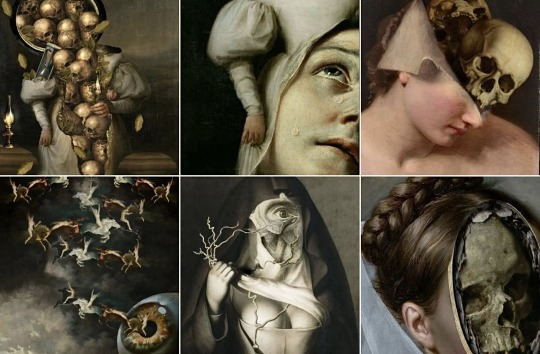
welderwings | Instagram
A tiny bit of fantastical absurdity – right in the palm of your hand. Type the name ‘Welder Wings’ (@welderwings) into your Instagram search bar and prepare to be consumed by deeply haunting works of art. The creations posted on the viral account seem to belong to a realm of nightmarish visions and chilling transformations: hordes of skulls are spilling out like rotten apples from half-hewn faces, parades of ponies are prancing in the sky while leaping out of enormous eyeballs, and human figures are mutating into hole-riddled vessels of sinister otherworldly souls. The world opening up in this little corner of the internet may perhaps not be for the faint-hearted. But it provides an undeniable thrill for all those drawn to the macabre.
Welder Wings is a passion project of the Spanish couple Francisco Abril and Nuria Velasco. The artist duo creates their Gothic-infused visuals through digital photo manipulation of Baroque or Romantic visual art. For example, THE INSENSATE BEAUTY (2024) is a bubbly execution scene in which Vigée Le Brun’s Marie Antoinette with a Rose (1783) suffers the same fate as her real-life counterpart. And in LAMENT OF MY STRANGLED HEART (2019), Caravaggio’s Judith (Judith Beheading Hologernes, 1602) gets her heart broken quite literally – through the gaping void replacing her face. Welder Wings’ works are subversive collages, transforming the serenity of the source material into scenes gruesome and grotesque.
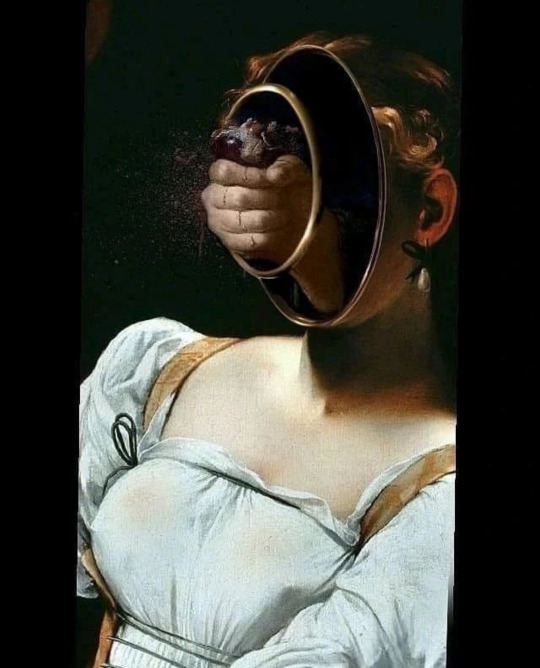
Welder Wings, LAMENT OF MY STRANGLED HEART (2019)
Abril and Velasco’s creations are undeniably surrealist. Their disruptive art forces us to plunge headfirst into the deep abyss of dreams and absurdity. Clearly, Welder Wings spreads its feathers decades after the official end of the 20th-century movement. But by making conscious references to surrealist artists and practices, the duo proves that its works are much more than digital forms of play. Rather, they are a proclamation of pastiche – a way to honor and continue the approach of their predecessors.
Form is Welder Wings’ most powerful tool. Although the works are careful to keep the aesthetic style of their source materials, evoking coherent looks of compositions in oil, they are the products of digital manipulation. With the power of image editing programs and the vast digital archive of visuals, the two artists have become architects of transfiguration. The collage has long been a method for surrealist visionaries. The juxtapositioning of pre-existing elements and resulting illogicality of images is a direct representation of the unfathomable, the unconscious, the unbelievable. For the Surrealist group, collages were delineations of dreams. And Welder Wings’ works certainly feel like dreams – terrible, terrifying dreams.

left: Welder Wings, WATER REFLECTION (2021), right: Dora Maar, Untitled (Shell Hand) (1934)
More than just understanding how to wield their predecessors’ weapons, Abril and Velasco do not shy away from directly quoting from the surrealist canon. If one takes the time to scroll through the account’s vastly-growing oeuvre, it becomes obvious just how much of its art integrates the movement’s achievements. The nature-claimed skeleton trees of DARK AUTUMN (2018) certainly could inhabit the same absurd landscapes that the likes of Salvador Dalí or Yves Tanguy have envisioned. Even more obvious of a reference is WATER REFLECTION (2021). The work pays a direct homage to Dora Maar’s Untitled (Shell Hand) (1934), a milestone of surrealist photomontage. The artist duo clearly extends a direct praise to those who came before them.
It is pleasurably disturbing to look at Welder Wings’ fantastical absurdity. The couple's collages are intricately-woven garments, fabrics stitched in order to become creations of dreams, delusions and death. By harnessing digital affordances and creating complex collages, the two artists maintain the avant-garde practices of the 20th-century Surrealist movement. Welder Wings’ has an undeniable awareness about the artistic past it has inherited – and it is not reluctant to credit it.
__________________ ༻¨*:·.
#surrealism#surrealist art#surrealist painting#collage art#contemporary art#digital collage#gothic aesthetic#review#art review#welder wings#instagram artist#thechimerasreviews
5 notes
·
View notes
Text
.·:*¨༺
“Perhaps my life is nothing but an image of this kind; perhaps I am doomed to retrace my steps under the illusion that I am exploring, doomed to try and learn what I simply should recognize, learning a mere fraction of what I have forgotten.”
— André Breton
3 notes
·
View notes
Text
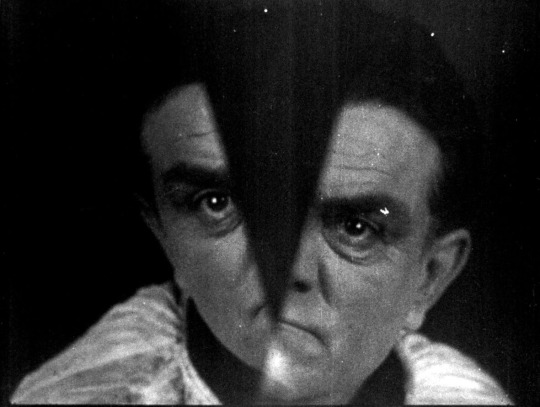
Germaine Dulac, The Seashell and the Clergyman (1928)
5 notes
·
View notes
Text
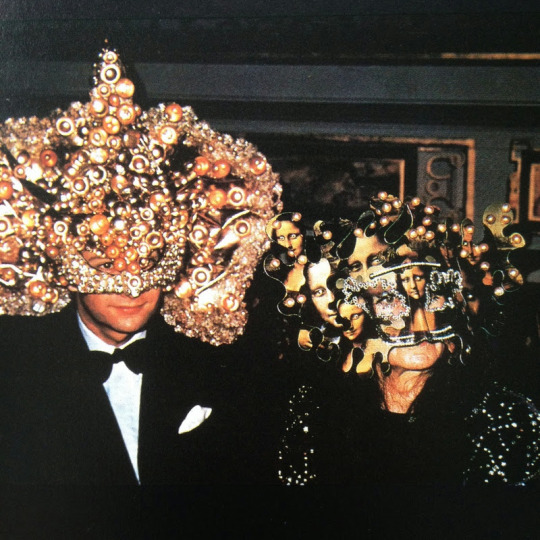
"If your family has the largest private fortune in history, the least you can do is hold a party at the most lavish chateau in France with costumes designed by Salvador Dalí, Audrey Hepburn in a birdcage hat and an interactive maze filled with butlers pretending to be cats."
One historic event I never get tired thinking about is the Surrealist Ball of 1972, hosted by none other than the Rothschild family. Certainly the party to be.
If you don't know anything about this little piece of history, check out this article and be prepared for some absurd costumes!
༻¨*:·.
13 notes
·
View notes
Text
reviews | absurd cinema | biopic | comic
𝐀𝐛𝐬𝐨𝐥𝐮𝐭𝐞𝐥𝐲 𝐀𝐛𝐬𝐮𝐫𝐝 𝐚𝐧𝐝 𝐂𝐨𝐦𝐢𝐜𝐚𝐥𝐥𝐲 𝐂𝐡𝐚𝐫𝐦𝐢𝐧𝐠
An artist biopic unlike anything you have ever seen
.·:*¨༺ __________________

Judith (Anaïs Demoustier) trying to conduct an interview with Salvador Dalí (Gilles Lellouche) on the beach.
How many Dalís is one too many? You might ask yourself this while watching Quentin Dupieux’s latest work. Daaaaaalí! (2023) is, as the screaming title already suggests, a film about the Spanish artist – but not like you have ever seen before. In the opening scene, mustache-twirling and cane-bearing Dalí (Gilles Lellouche) strides down a hotel corridor. Only for Dalí (Édouard Baer) to walk its length once more. And then, who would have guessed, Dalí (Jonathan Cohen) does it all over again. In this comic prelude, the ever-body-changing character is late for an interview but never seems to arrive at his destination as the distance of the hallway stretches into infinity.
Daaaaaalí! is full of such amusing instances. Dupieux’s film depicts a young pharmacist-turned-journalist, Judith (Anaïs Demoustier), who attempts to start off her new career path by meeting one of the biggest artist names of the 20th century. What begins as a simple interview with the surrealist ends up being a headlong plunge into his whimsical world. Judith soon realizes that Dalí has his own ideas about her project. And while the interview turns into a documentary film that never gets off the ground, reality is turned upside down. Characters wake up from dreams that never end, dead dogs rain down from a cloudless sky, and gun-slinging cowboys terrorize art auctions.
Sounds a little absurd? Well, that’s exactly the point. The film successfully manages to break out of the never-ending stream of solemn self-assertive biopics by being less concerned with an accurate portrayal of reality and more with crafting a tone that honors the ethos of the historical figure. What makes the work so cleverly charming is that Dupieux has encapsulated the bygone spirit of Surrealism in contemporary form. Daaaaaalí! is a delicious accumulation of absurdity, much like the movement itself.
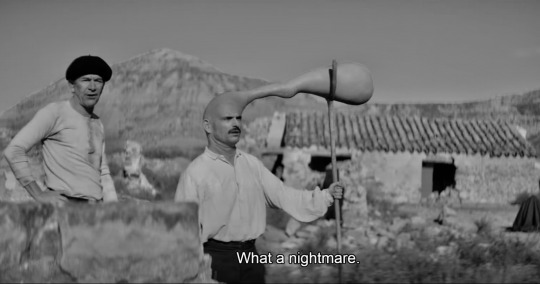
Two of Dalí’s models posing for the artist’s painting.
In an early scene in the film, a highly-focused Dalí is seen sitting in the midst of a desolate landscape. With close precision, he is applying brush strokes to his easel. “Sir! Can we take a break?” comes a shout off-screen. The camera whips around to reveal a baffling setting. The two men acting as the painter’s models possess strangely disfigured proportions, one of them propping up his grotesquely elongated head with a wooden pitchfork. The scene pays a delightful homage to Dalí’s 1932 The Fine and Average Invisible Harp by transforming his vision into cinematic reality. And even beyond such clear referentialities, the film’s visual themes closely evoke the artist’s comically-constructed compositions. Dupieux has reached deep into Dalí’s palette, painting a Surrealist masterpiece of his own.
Daaaaaalí! certainly is a testimonial to the persistence of the bizarre. At the same time, the film works so well because it does not try to infuse the scenes with a layer of sober significance. It departs from a purely rational treatment of the narrative it creates. Instead, the events on-screen rely on ridiculousness. The audience is expected to laugh, to get lost in the endless comedic repetitions and the silly oddities of the characters. When Dalí is involved nothing makes sense, nor does it have to. Consequently, watching the film is a lot like contemplating one of the painter’s works: initially confusing, undoubtedly absurd, yet highly entertaining for eyes and mind.
With that, Dupieux's work tells more about Surrealist ideas than many previous documentaries out there could. Daaaaaalí! has manifested itself as a monument to the movement, a rollercoaster of funkiness and madness that the painter himself would have certainly appreciated.
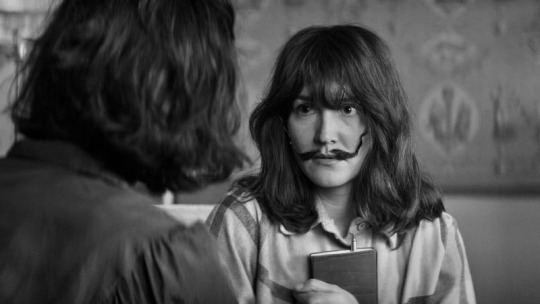
Judith (Anaïs Demoustier) wearing the Dalí mustache.
__________________ ༻¨*:·.
#surrealism#surrealist art#surrealist cinema#surrealist film#absurd cinema#cinema#film#review#film review#quentin dupieux#salvador dali#biopic#french cinema#thechimerasreviews
3 notes
·
View notes
